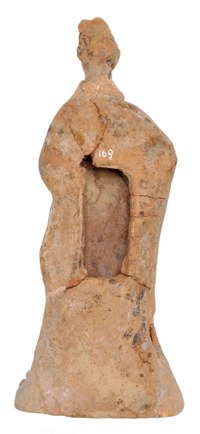Female figurine in robe with bow hairstyle, "Tanagra figurine"
Description: On a flat rectangular plinth rises a youthful female figurine in floor-length chiton and a cloak that forms a kind of low 'collar', covering the front including the arms and reaching above the knees. The front section of the left shoe peeks out from under the chiton. The right leg is indicated by slightly wider arched folds. The right arm is propped up at the side, the left bent forward. The hand grasps a piece of cloth from the inside. From there, diagonal folds run up to the slightly rising hem. Further diagonal folds stretch out between the right elbow and the upper part of the body or the hip.
The parted hair is coiffed in wavy strands and gathered into a bow on top of the head. Long strands of curls fall down to the shoulders.
The head is tilted and turned to the left. The oval face is dominated by the nose. The small deep-set eyes are wide apart. Full lips form the closed mouth, the angles of which are accentuated by dimples.
Commentary: As with the Tanagra figurine T I-18, the right arm of the statuette T I-36 is supported at the side and the front is completely covered by the cloak. The posture and fabric quality are different, however. The fine fabric allows the body forms to stand out clearly. The mantle does not now fall loosely over the right elbow; rather, the outer edge runs diagonally towards the right side of the body under slight tension, where the contour line then merges with that of the chiton. With her right hip pushed out, her waist drawn in and her head turned to the left, T I-36 conveys rhythmic movement. The side view shows a slight S-shape.
So far, there is no exact parallel. Similarities in the stance and in the drapery of the garments exist above all with specimens from Tanagra[1].
T I-36, is likely to have been made in the 3rd century BC, although much later than T I-18. The orderly looped hairstyle also fits in with this. Judging by the colour of the clay, the statuette could come from a Boeotian workshop.
Determination: Advanced 3rd century BC; Tanagra?
 |
 |
 |
|---|
[1] S. Besques, Cat. Raisonné des Figurines et Reliefs enterrecuitegrecsétrusques et romains III, 1 (Paris 1971/72) 22 pl. 23 c; L. Burn – R. Higgins, Cat. of Greek Terracottas in the British Museum 3 (London 2001) 47 f. nos. 2051. 2052 pl. 10; V. Jeammet, Tanagra (Paris 2003) 204 fig. 137; E. Kountouri – A. Harami – V. Vivliodetis, Coroplastic Art from Thebes (Boeotia). Evidence from Terracotta Figurines Found in Graves, BCH Suppl. 54, 2016, 186 no. E 125 fig.12; Jeammet ibid. 204 fig. 137; Winter 2, 1903, 22, 4.

